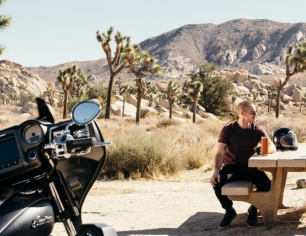Tips for buying a used motorcycle
Buying a used motorcycle can reduce the overall cost of owning a bike, but you need to know what to look for when purchasing a used motorcycle. Signs of damage or abuse could lead to expensive repairs that negate your savings from buying used. If you buy from a responsible owner or a reputable dealer, you minimize the risk of buying a bike with severe damage.
Explore Progressive's editorial standards for Answers articles to find out why you can trust the insurance information you find here.
What to look for when buying a used motorcycle
Follow our used motorcycle checklist for every component to examine before you purchase your used bike.
Check for damage
Used motorcycles can sometimes hide a lot of damage and problems. If the motorcycle has dings, scuff marks, or rust, its condition may indicate that it wasn't maintained well. On the other hand, a clean bike shows the owner took care of it and likely kept it in a covered garage.
Check the tires
Look at the level of wear on the tires. Most motorcycles will have some level of wear and tear, but if you see severe wear or damage to the tires, it points to the rider burning out or possibly using it on a racetrack. Ask the seller how they used the bike before showing interest.
You can check the numbers outside the tires to find out how old they are. Most motorcycle tires will last around six years. If the tires are nearing replacement age, you can use this information to negotiate the price while factoring in the cost of new tires.
Assess oil and coolant levels
Oil should look like syrup. This means it's new or has been recently changed. Thick black oil means it hasn't been changed in a while but isn't necessarily indicative of problems. However, silver or milky oil means water is somehow entering the engine and signifies a major repair could be needed.
Coolant typically smells sweet and has a green color to it. If you see brown coolant, it can mean another substance, such as rust or oil, is mixing with the coolant. If you see this, you may want to reconsider the purchase.
Ask for the VIN and vehicle service records
Motorcycles are a high-theft item. Ensure the vehicle identification number (VIN) matches the title. If there are discrepancies between the information on the title and what you see in front of you, be wary of the seller.
Knowing how often the motorcycle was serviced also gives you an idea of how well the previous owner maintained the machine.
Take it for a test drive
You should always examine a motorcycle "cold," which means it shouldn't be running when you begin your inspection. Ensuring the motorcycle is off and hasn't been started recently means you can check how well it starts, look for issues in the exhaust, and much more.
Test the brakes, shift the gears and make sure all of the lights are in working order. Check the motorcycle's fuel tank. Open it up and look inside for any floating debris, and signs of rust. Learn more about how to test drive a motorcycle.
What questions should I ask when buying a used motorcycle?
Whether you're buying from a motorcycle from a dealership or a private seller, there are several questions you should ask when buying a used motorcycle.
Has the bike been involved in a crash?
Is there a warranty?
What is the mileage?
What is the service history?
When was the last time the bike was driven?
Learn more about buying a new vs. buying a used motorcycle.
Red flags when buying a used motorcycle
Here are some indicators of potential problems down the road in a used bike:
Leakage from the transmission/engine
Notable scratches and rust
Altered vehicle identification number
Wear and tear to the chain and sprockets
When was the last time the bike was driven?
What’s considered high mileage for a used motorcycle?
You may be content buying a motorcycle with significant mileage because it makes the bike more affordable. But how much is too much? That may depend on the type of bike. Larger motorcycles, like cruisers, are often more durable and can handle more miles than smaller bikes, such as sport bikes. High performance, sporty motorcycles may be considered high mileage at 25,000 miles whereas classic, bigger bikes may not classify as high mileage until 40,000 to 50,000.
Just purchased a used motorcycle? Insure it with Progressive by getting a motorcycle insurance quote online or by calling 1-866-749-7436.

Enjoy life on two wheels with motorcycle insurance from Progressive
Learn more about our motorcycle insurance offering.









